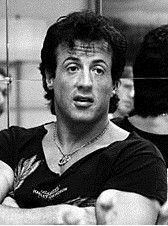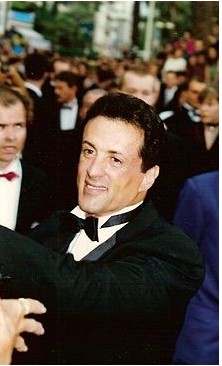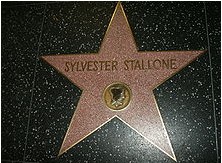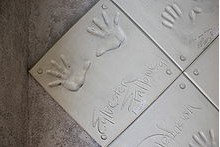
Sylvester Stallone
Wikipedia | 2013-01-21 13:53

Michael Sylvester Gardenzio Stallone (/stəˈloʊn/; born July 6, 1946), known as Sylvester Stallone, is an American actor, filmmaker, screenwriter, film director and occasional painter. Stallone is well known for his Hollywood action roles. Two notable characters he has portrayed are the boxer Rocky Balboa and soldier John Rambo.
Stallone's film Rocky was inducted into the National Film Registry as well as having its film props placed in the Smithsonian Museum. Stallone's use of the front entrance to the Philadelphia Museum of Art in the Rocky series led the area to be nicknamed the Rocky Steps. Philadelphia has a statue of his Rocky character placed permanently near the museum. It was announced on December 7, 2010 that Stallone was voted into boxing's Hall of Fame.
Early life
Sylvester Stallone was born Michael Sylvester Gardenzio Stallone[1][4] in New York City, the elder son of Frank Stallone, Sr., a hairdresser, and Jackie Stallone (born Jacqueline Labofish), an astrologer, former dancer, and promoter of women's wrestling. Stallone's father was born in Gioia del Colle, Apulia, Italy, and emigrated to the United States as a child.[5] Stallone's mother is of half Russian Jewish and half French descent.
Complications his mother suffered during labor forced her obstetricians to use two pairs of forceps during his birth; misuse of these accidentally severed a nerve and caused paralysis in parts of Stallone's face.[8][9] As a result, the lower left side of his face is paralyzed - including parts of his lip, tongue, and chin - an accident which has given Stallone his snarling look and slightly slurred speech.Stallone was baptized Catholic.His father, a beautician, moved the family to Washington, D.C., where he opened a beauty school. His mother opened a women's gymnasium called Barbella's in 1954. His younger brother is actor and musician Frank Stallone. Their parents divorced when Sylvester was nine, and he eventually lived with his mother.[9] He attended Notre Dame Academy and Lincoln High School in Philadelphia. He attended Charlotte Hall Military Academy prior to attending Miami Dade College and the University of Miami.
Hollywood career
When Stallone was nearly broke in New York, barely $50 to his name, he sold the script to Paradise Alley for $100.
Italian Stallion and Score
Stallone had his first starring role in the soft core pornography feature film The Party at Kitty and Stud's (1970). He was paid $200 for two days' work.[15] Stallone later explained that he had done the film out of desperation after being evicted from his apartment and finding himself homeless for several days. He has also said that he slept three weeks in the New York City Port Authority bus station prior to seeing a casting notice for the film. In the actor's words, "it was either do that movie or rob someone, because I was at the end – the very end – of my rope". The film was released several years later as Italian Stallion, in order to cash in on Stallone's new found fame (the new title was taken from Stallone's nickname since Rocky and a line from the film).
Stallone also starred in the erotic off-Broadway stage play Score which ran for 23 performances at the Martinique Theatre from October 28 – November 15, 1971 and was later made into a film by Radley Metzger.
1970–1975: Early film roles
In 1970, Stallone appeared in the film No Place to Hide, which was re-cut and retitled Rebel, the second version featuring Stallone as its star. After the style of Woody Allen's What's Up, Tiger Lily?, this film, in 1990, was re-edited from outtakes from the original movie and newly shot matching footage, then redubbed into an award-winning parody of itself titled A Man Called... Rainbo. Again starring Stallone, this self-parody was directed by David Casci and produced by Jeffrey Hilton. A Man Called...Rainbo won Silver Awards at the Chicago International Film Festival and Worldfest – Houston. It was featured on Entertainment Tonight along with its credited star, Sylvester Stallone. It received a Thumbs-Up on Siskel & Ebert and was recommended by Michael Medved on the movie review show, Sneak Previews.
Stallone's other first few film roles were minor, and included brief uncredited appearances in Woody Allen's Bananas (1971) as a subway thug, in the psychological thriller Klute (1971) as an extra dancing in a club, and in the Jack Lemmon film The Prisoner of Second Avenue (1975) as a youth. In the Lemmon film, Jack Lemmon's character chases, tackles and mugs Stallone, thinking that Stallone's character is a pickpocket. He had his second starring role in The Lords of Flatbush, in 1974. In 1975, he played supporting roles in Farewell, My Lovely; Capone; and Death Race 2000. He made guest appearances on the TV series Police Story and Kojak.
Success with Rocky

Stallone at the Oscars in 1978
Stallone gained worldwide fame with his starring role in the smash hit Rocky (1976). On March 24, 1975, Stallone saw the Muhammad Ali–Chuck Wepner fight, which inspired the foundation idea of Rocky. That night Stallone went home, and after three days,[18] 20 straight hours he had written the script. He tried to sell the script with the intention of playing the lead role. Robert Chartoff and Irwin Winkler liked the script.[citation needed] Stallone was offered increasingly larger fees to sell the script and allow a different actor to star in the film, but he turned the offers down until the studio agreed to let Stallone himself play the role.
Rocky was nominated for ten Academy Awards, including Best Actor and Best Original Screenplay nominations for Stallone. The film went on to win the Academy Awards for Best Picture, Best Directing and Best Film Editing.
More Rocky, Rambo, and additional roles
Following the success of Rocky, Stallone made his directorial debut and starred in the 1978 film Paradise Alley, a family drama in which he played one of three brothers who enter the world of wrestling. That same year he starred in Norman Jewison's F.I.S.T., a social drama in which he plays a warehouse worker, very loosely modeled on James Hoffa, who becomes involved in the labor union leadership. In 1979 he wrote, directed and starred in the sequel to his 1976 hit: Rocky II (replacing John G. Avildsen, who won an Academy Award for directing the first film), which also became a major success,[9] grossing $200 million.

Stallone in 1988
In 1981 he starred alongside Michael Caine in Escape to Victory, a sports drama in which he plays a prisoner of war involved in a Nazi propaganda soccer game. That same year he starred in the thriller Nighthawks, in which he plays a New York city cop who plays a cat and mouse game with a foreign terrorist, played by Rutger Hauer.

Stallone with Brigitte Nielsen, Ronald Reagan and Nancy Reagan at the White House, 1985
Stallone launched another major franchise success, starring as Vietnam veteran John Rambo, a former Green Beret, in the action-war film First Blood (1982). The first installment of Rambo was both a critical and box office success. Critics praised Stallone's performance, saying he made Rambo seem human, as opposed to the way he is portrayed in the book of the same name. Two Rambo sequels, Rambo: First Blood Part II (1985) and Rambo III (1988), followed. Although box office hits, they met with much less critical praise than the original.[citation needed] He also continued his box office success with the Rocky franchise and wrote, directed, and starred in two more sequels to the series: Rocky III (1982) and Rocky IV (1985). Stallone has portrayed these two characters in a total of ten films. In preparation for these roles, Stallone embarked upon a vigorous training regimen which often meant six days a week in the gym and further sit ups in the evenings. Stallone claims to have gotten his body fat percentage down to his all time low of 2.8% for Rocky III.[20] Stallone met former Mr. Olympia Franco Columbu to develop the appearance for Rocky II and Rambo II films, just as if he were preparing for the Mr. Olympia competition. That meant two workouts a day, six days a week.
During this time period, Stallone cultivated a strong overseas following. He also attempted, albeit unsuccessfully, roles in different genres. In 1984 he co-wrote and starred in the comedy film Rhinestone where he played a wannabe country music singer and in 1987 he starred in the drama film Over the Top where he played a struggling trucker who, after the death of his wife, tries to make amends with his son who he left behind years earlier. His son does not think too highly of him until he sees him compete in a nation-wide arm wrestling competition. For the Rhinestone soundtrack, he performed a song. These films did not do well at the box office and were poorly received by critics. It was around 1985 that Stallone was signed to a remake of the 1939 James Cagney classic Angels With Dirty Faces. The film would form part of his multi-picture deal with Cannon Pictures and was to co-star Christopher Reeve and be directed by Menahem Golan. The re-making of such a beloved classic was met with disapproval by Variety and horror by top critic Roger Ebert. Cannon opted to make Cobra instead. Cobra (1986) and the buddy cop action film Tango and Cash (1989) alongside Kurt Russell did solid business domestically but overseas they did blockbuster business, grossing over $100 million in foreign markets and over $160 million worldwide.

Stallone at the 1993 Cannes Film Festival
After the success of Lock Up[citation needed] and Tango and Cash at the start of the 1990s, Stallone starred in the fifth installment of the Rocky franchise, Rocky V. It was considered a box office disappointment and was also disliked by fans as an unworthy entry in the series.He starred in two comedies, the critical and commercial disasters Oscar (1991) and Stop! Or My Mom Will Shoot (1992) during the early '90s. In 1993 he made a comeback with the hit Cliffhanger, which was a success in the US, grossing $84 million, but even more successful worldwide, grossing $171 million. Later that year, he starred with Wesley Snipes in the futuristic action film Demolition Man, which grossed over $158 million worldwide. His string of hits continued with 1994's The Specialist (over $170 million worldwide gross). In 1995, he played the futuristic character Judge Dredd (from the British comic book 2000 AD) in Judge Dredd. His overseas box office appeal saved the domestic box office disappointment of Judge
Dredd, which cost almost $100 million and barely made its budget back, with a worldwide tally of $113 million. He also appeared in the thriller Assassins (1995) with Julianne Moore and Antonio Banderas. In 1996, he starred in the disaster film Daylight, which was not very successful in the US, but grossed $126 million overseas.
That same year, Stallone, along with an all-star cast of celebrities, appeared in the Trey Parker and Matt Stone short comedy film "Your Studio and You" commissioned by the Seagram Company for a party celebrating their acquisition of Universal Studios and the MCA Corporation. Stallone speaks in his Rocky Balboa voice with subtitles translating what he is saying. At one point, Stallone starts yelling about how can they use his Balboa character, that he left it in the past; the narrator calms him with a wine cooler and calling him "brainiac." In response, Stallone says, "Thank you very much." He then looks at the wine cooler and exclaims, "Stupid cheap studio!"
Following his breakthrough performance in Rocky, critic Roger Ebert had stated that Stallone could become the next Marlon Brando, though he never recaptured the critical acclaim achieved with Rocky. Stallone did go on to receive much acclaim for his role in the low-budget crime drama Cop Land (1997), in which he starred alongside Robert De Niro and Ray Liotta, but the film was only a minor success at the box office.[citation needed] His performance led him to win the Stockholm International Film Festival Best Actor Award. In 1998 he did voice-over work for the computer-animated film Antz, which was a big hit domestically.
In 2000, Stallone starred in the thriller Get Carter – a remake of the 1971 British Michael Caine film of the same name—but the film was poorly received by both critics and audiences. Stallone's career declined considerably after his subsequent films Driven (2001), Avenging Angelo (2002) and D-Tox (2002) also underachieved expectations to do well at the box office and were poorly received by critics.
2003–2005
In 2003, he played a villainous role in the third installment of the Spy Kids trilogy Spy Kids 3-D: Game Over which was a huge box office success (almost $200 million worldwide). Stallone also had a cameo appearance in the 2003 French film Taxi 3 as a passenger.
Following several poorly reviewed box office flops, Stallone started to regain prominence for his supporting role in the neo-noir crime drama Shade (2003) which was only released in a limited fashion but was praised by critics. He was also attached to star and direct a film tentatively titled Rampart Scandal, which was to be about the murder of rappers Tupac Shakur and The Notorious B.I.G. and the surrounding Los Angeles Police Department corruption scandal.[24] It was later titled Notorious but was shelved.
In 2005, he was the co-presenter, alongside Sugar Ray Leonard, of the NBC Reality television boxing series The Contender. That same year he also made a guest appearance in two episodes of the television series Las Vegas. In 2005, Stallone also inducted wrestling icon Hulk Hogan, who appeared in Rocky III as a wrestler named Thunderlips, into the WWE Hall of Fame; Stallone was also the person who offered Hogan the cameo in Rocky III.
2006–2008: Revisiting Rocky and Rambo

Sylvester Stallone Hollywood Star on Hollywood Walk of Fame
After a three-year hiatus from films, Stallone made a comeback in 2006 with the sixth installment of his successful Rocky series, Rocky Balboa, which was a critical and commercial hit. After the critical and box office failure of the previous installment Rocky V, Stallone had decided to write, direct and star in a sixth installment which would be a more appropriate climax to the series. The total domestic box office came to $70.3 million (and $155.7 million worldwide).[27] The budget of the movie was only $24 million. His performance in Rocky Balboa has been praised and garnered mostly positive reviews.
Stallone's fourth installment of his other successful movie franchise is titled simply Rambo. The film opened in 2,751 theaters on January 25, 2008, grossing $6,490,000 on its opening day and $18,200,000 over its opening weekend. Its box office was $113,244,290 worldwide with a budget of $50 million.
Asked in February 2008 which of the icons he would rather be remembered for, Stallone said "it's a tough one, but Rocky is my first baby, so Rocky."
Other film work
Stallone's debut as a director came in 1978 with Paradise Alley, which he also wrote and starred in. In addition, he directed Staying Alive, the sequel to Saturday Night Fever, along with Rocky II, Rocky III, Rocky IV, Rocky Balboa, and Rambo. In August 2005, Stallone released his book Sly Moves which claimed to be a guide to fitness and nutrition as well as a candid insight into his life and works from his own perspective. The book also contained many photographs of Stallone throughout the years as well as pictures of him performing exercises. In addition to writing all six Rocky films, Stallone also wrote Cobra, Driven, and Rambo. He has co-written several other films, such as F.I.S.T., Rhinestone, Over the Top, and the first three Rambo films. His last major success as a co-writer came with 1993's Cliffhanger. In addition, Stallone has continued to express his passion in directing a film on Edgar Allan Poe's life, a script he has been preparing for years. In July 2009, he appeared in a cameo in the Bollywood movie Kambakkht Ishq where he played himself.[30] Stallone also provided the voice of a lion in Kevin James's comedy Zookeeper. Stallone has also mentioned that he would like to adapt a Nelson DeMille novel, The Lion's Game and James Byron Huggin's novel Hunter, which Stallone had the film rights for several years and originally planned to use the plot from Hunter for Rambo V. In 2009, Stallone expressed interest in starring in a remake of Charles Bronson's 1974 movie Death Wish.
2010 onwards
The Expendables was Stallone's big success of 2010. The movie, which was filmed during summer/winter 2009, was released on August 13, 2010. Stallone wrote, directed and starred in the movie. Joining him in the film were fellow action stars Jason Statham, Jet Li, and Dolph Lundgren, as well as Terry Crews, Mickey Rourke, Randy Couture, Eric Roberts, and Stone Cold Steve Austin, and cameos by fellow '80s action icons Bruce Willis and Arnold Schwarzenegger.[32] The movie took $34,825,135 in its opening weekend, going straight in at No. 1 in the US box office. The figure marked the biggest opening weekend in Stallone's career. In summer 2010, Brazilian company O2 Filmes released a statement saying it was still owed more than US$2 million for its work on the film. The Expendables 2 was released August 17, 2012 to a positive critical reception of 67% on Rotten Tomatoes, as opposed to the original's 41%.
Stallone stars in the action film Bullet to the Head, directed by Walter Hill, based upon Alexis Nolent's French graphic novel Du Plomb Dans La Tete. In 2013, he will be starring in the action thriller film The Tomb along with Arnold Schwarzenegger and Jim Caviezel. Stallone expressed interest in making a remake of the Spanish film No Rest for the Wicked and to star in a fifth Rambo film.
Tobacco promotion
In 1983, Stallone entered into an agreement with Associated Film Promotions, Inc. representing their client, cigarette manufacturer Brown & Williamson Corp., to use or place B&W products in five of his feature films.[39] In exchange, Stallone was paid a total of $500,000, disbursed as $250,000 up front and $50,000 "payable at the inception of production of each participating film." In the initial correspondences Stallone guaranteed that he would "use Brown and Williamson tobacco products in no less than five feature films" but later, to be consistent with the character of Rocky Balboa, it was decided that "other leads will have product usage" in Rocky IV. In 2002 documentation of the agreement was made publicly available through the Legacy Tobacco Documents Library at the University of California, San Francisco.
Personal life

Handprints of Sylvester Stallone
Stallone has been married three times. At age 28, on December 28, 1974, he married German American Sasha Czack from Pennsylvania. The couple had two sons, Sage Moonblood (May 5, 1976 - July 13, 2012) and Seargeoh (b. 1979). His younger son was diagnosed with autism at an early age. The couple divorced on February 14, 1985. He married model and actress Brigitte Nielsen, on December 15, 1985, in Beverly Hills, California. Stallone and Nielsen's marriage, which lasted two years, and their subsequent divorce, were highly publicized by the tabloid press. In May 1997, Stallone married Jennifer Flavin, with whom he has three daughters. In 2007, customs officials in Australia discovered 48 vials of the synthetic human growth hormone Jintropin in his luggage.[45] After Stallone's request that his acting and life experiences be accepted in exchange for his remaining credits, he was granted a Bachelors of Fine Arts (BFA) degree by the President of the University of Miami in 1999.
His 48 year old half-sister, Toni Ann Filiti, died of lung cancer, six weeks after the death of his son, Sage. She succumbed to lung cancer on Sunday, August 26, 2012. She died at their mother Jackie Stallone's Santa Monica home after choosing to leave UCLA hospital.
Stallone stopped going to church as his acting career progressed but later rediscovered his childhood faith when his daughter was born ill in 1996, and is now an active Catholic.
Share this page



















